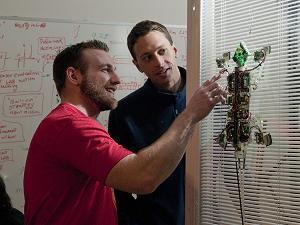Stanford’s Stickybot is Climbing Faster, Human Project Coming Soon? (video)

Share
Geckos may be good at selling car insurance, but they're even better at climbing walls. Which is why Stanford's Biomimetics and Dexterous Manipulation Lab used the acrobatic reptiles as the model for their vertically climbing robot. The Stickybot can ascend wood paneling, painted metal, even glass using a dry adhesive that only clings in one direction. The most recent version of the robot uses a new generation of the adhesive that doesn't require it to flex its toes and that increases its climbing speed noticeably. The new adhesive is working so well that a human scale system (called Z-man) is in the works. Check out the latest Stickybot in the videos below. It looks perfectly at home on a pane of glass.
The Stickybot was one of the first robots we reviewed that took such inspiration from nature. Its directional adhesive is a rubber-like substance with microscopic polymer hairs - very similar to the flaps of skin and hairs on a gecko's toes. The tail of the bot isn't just for aesthetics, engineers found that it was a necessary weight balance for robots and reptiles alike. Now, engineers are upgrading the components of the bot and improving its performance. Compare the most recent footage of the climbing robot (1st video) with an earlier model from 2008 (2nd video). The bot is getting faster and less complicated in its foot movements.
Be Part of the Future
Sign up to receive top stories about groundbreaking technologies and visionary thinkers from SingularityHub.


Planned upgrades for the Stickybot will make it even more gecko-like. The Biomimetics lab plans on giving it rotating ankles - a necessity if you want the robot to change course using directional adhesives. Along with improving the robots, the adhesive is likely to be included in other systems. According to Stanford University News, the Z-man project will scale up the material for use by humans. Letting people climb up vertical glass surfaces without complicated suction cups? Sounds like a new awesomely dangerous sport. I wonder who they will get to provide insurance coverage?
[image credit: L.I. Cicero/Stanford University]
[video credits: Jack Hubbard, Stanford University]
[source: Stanford News, Biomimetics and Dexterous Manipulation Lab, Soto et al, APL 2010]
Related Articles

These Robots Are the Size of Single Cells and Cost Just a Penny Apiece

In Wild Experiment, Surgeon Uses Robot to Remove Blood Clot in Brain 4,000 Miles Away

A Squishy New Robotic ‘Eye’ Automatically Focuses Like Our Own
What we’re reading
